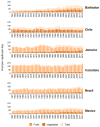Obesity and the food system transformation in Latin America
- PMID: 29691969
- PMCID: PMC6103889
- DOI: 10.1111/obr.12694
Obesity and the food system transformation in Latin America
Abstract
The Latin America and the Caribbean (LAC) region faces a major diet-related health problem accompanied by enormous economic and social costs. The shifts in diet are profound: major shifts in intake of less-healthful low-nutrient-density foods and sugary beverages, changes in away-from-home eating and snacking and rapid shifts towards very high levels of overweight and obesity among all ages along with, in some countries, high burdens of stunting. Diet changes have occurred in parallel to, and in two-way causality with, changes in the broad food system - the set of supply chains from farms, through midstream segments of processing, wholesale and logistics, to downstream segments of retail and food service (restaurants and fast food chains). An essential contribution of this piece is to marry and integrate the nutrition transition literature with the literature on the economics of food system transformation. These two literatures and debates have been to date largely 'two ships passing in the night'. This review documents in-depth the recent history of rapid growth and transformation of that broad food system in LAC, with the rapid rise of supermarkets, large processors, fast food chains and food logistics firms. The transformation is the story of a 'double-edged sword', showing its links to various negative diet side trends, e.g. the rise of consumption of fast food and highly processed food, as well as in parallel, to various positive trends, e.g. the reduction of the cost of food, de-seasonalization, increase of convenience of food preparation reducing women's time associated with that and increase of availability of some nutritious foods like meat and dairy. We view the transformation of the food system, as well as certain aspects of diet change linked to long-run changes in employment and demographics (e.g. the quest for convenience), as broad parameters that will endure for the next decades without truly major regulatory and fiscal changes. We then focus in on what are the steps that are being and can be taken to curb the negative effects on diet of these changes. We show that countries in LAC are already among the global leaders in initiating demand-related solutions via taxation and marketing controls. But we also show that this is only a small step forward. To shift LAC's food supply towards prices that incentivize consumption of healthier diets and demand away from the less healthy component is not simple and will not happen immediately. We must be cognizant that ultimately, food industry firms must be incentivized to market the components of healthy diets. This will primarily need to be via selective taxes and subsidies, marketing controls, as well as food quality regulations, consumer education and, in the medium term, consumers' desires to combine healthier foods with their ongoing quest for convenience in the face of busy lives. In the end, the food industry in LAC will orient itself towards profitable solutions, ie those demanded by the broad mass of consumers.
Keywords: Food service; food system; obesity; retailers.
© 2018 The Authors. Obesity Reviews published by John Wiley & Sons Ltd on behalf of World Obesity Federation.
Conflict of interest statement
No conflict of interest was declared.
Figures















References
-
- Rivera JÁ, de Cossío TG, Pedraza LS, Aburto TC, Sánchez TG, Martorell R. Childhood and adolescent overweight and obesity in Latin America: a systematic review. Lancet Diabetes Endocrinol. 2014;2:321–332. - PubMed
-
- Anauati MV, Galiani S, Weinschelbaum F. The rise of noncommunicable diseases in Latin America and the Caribbean: challenges for public health policies. Latin Am Econ Rev. 2015;24:11.
Publication types
MeSH terms
Grants and funding
LinkOut - more resources
Full Text Sources
Other Literature Sources
Medical
Miscellaneous

